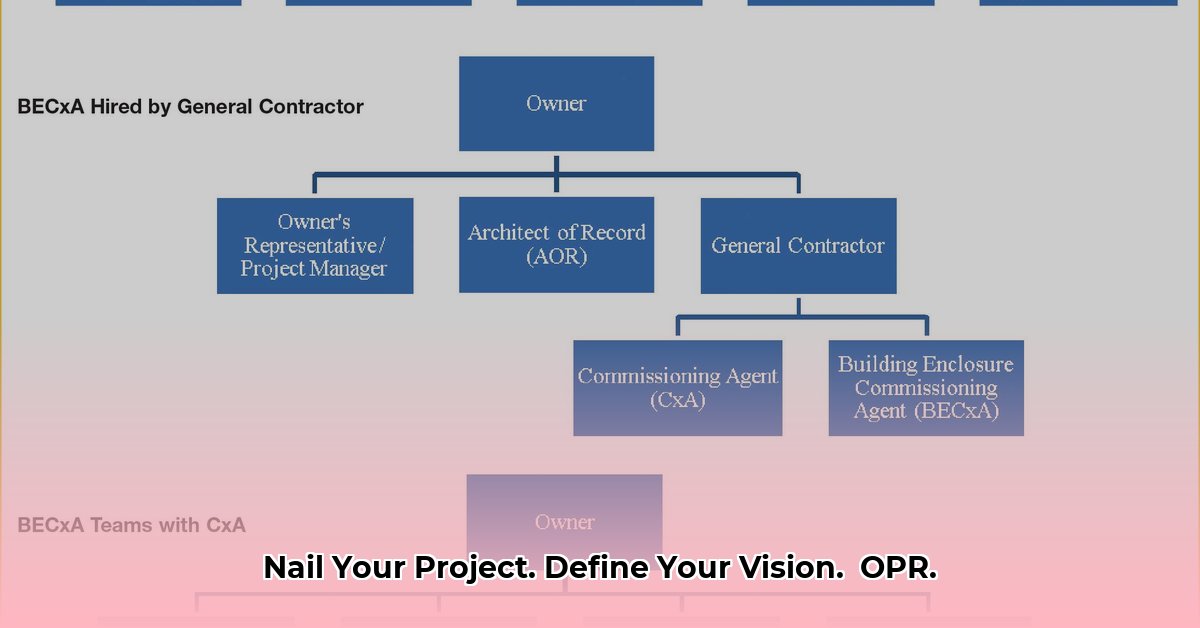Understanding the Power of the OPR
Building a project without a clear plan is like navigating uncharted waters. You might reach your destination eventually, but the journey will likely be fraught with unexpected challenges and costly detours. The Owner’s Project Requirements (OPR) is your compass and chart, guiding your project toward a successful completion. It’s the document that translates your vision into concrete, actionable steps, ensuring everyone involved understands the objectives and their roles in achieving them.
What is an OPR?
The OPR is essentially a detailed wish list for your project, outlining everything from overarching goals to minute specifics. It’s the document that bridges the gap between your vision and the final product, ensuring the building not only looks right but also functions right. Think of it as a comprehensive conversation with your architect, contractors, and every other stakeholder before the first nail is hammered, establishing a shared understanding and minimizing costly misunderstandings down the line.
Why is an OPR essential?
Developing a robust OPR may seem like an extra step, but it’s an investment that pays dividends throughout the project lifecycle. It minimizes the risk of scope creep, keeps the project on track, and ensures that the final product aligns with your initial vision. A well-defined OPR also fosters clear communication, reduces the likelihood of disputes, and streamlines the decision-making process.
Crafting Your OPR: A Step-by-Step Guide
Creating a comprehensive OPR is a collaborative process involving various stakeholders. Here’s a step-by-step guide to help you navigate the process:
1. Project Inception: Defining the Vision
Before diving into specifics, assemble your project team, including the owner, commissioning provider (CxP), designers, contractors, and key facility personnel. This initial meeting serves as a brainstorming session, allowing you to collectively define project goals, establish success criteria, and outline budgetary and scheduling constraints.
2. Building Your OPR: Key Components
The following components form the foundation of your OPR:
- Executive Summary: A concise overview of the project, highlighting key objectives and expected outcomes.
- Project Description: A detailed explanation of the project’s purpose, scope, and intended use, including any special features or considerations.
- Budget and Schedule: A realistic budget allocation with contingency planning and a clear timeline with key milestones.
- Commissioning Scope and Budget (if applicable): Specific requirements and budget for commissioning activities, particularly for complex systems like HVAC&R.
- Functional Requirements: Essential functions and performance criteria that the building must fulfill, addressing aspects like capacity, accessibility, and efficiency.
- Operational Requirements: Day-to-day operational procedures, including maintenance, security, staffing, and any specialized protocols.
- Acceptance Criteria: Specific, measurable standards and tests for verifying project completion and ensuring that the final product meets all requirements.
- Sustainability Requirements: Environmental considerations, energy efficiency targets, and other sustainability goals, including potential LEED certification requirements.
- Future-Proofing Considerations: Addressing potential future needs and technological advancements, allowing for adaptability and scalability over time. This might include provisions for future expansion, integration of smart technologies, or adaptable infrastructure for evolving needs. This section should also discuss how decisions documented in the OPR support a sustainable approach to whole-life asset management.
3. Refinement and Review: Ensuring Alignment
Circulate the draft OPR for review and feedback from all stakeholders. This iterative process ensures that everyone has a voice and that the final document accurately reflects the shared vision. Be open to revisions and suggestions, as this collaborative approach strengthens the OPR and minimizes potential conflicts down the line.
4. Implementation and Handover: Guiding the Project
Once approved, the OPR becomes the central guiding document for the project. It serves as a reference point for all decisions, ensuring consistency and alignment with the original vision. Upon project completion, the final, approved OPR transitions into a valuable asset for ongoing facility management, providing a comprehensive record of design intent, operational requirements, and maintenance guidelines.
Best Practices and Potential Pitfalls
- Embrace Collaboration: Involve all stakeholders throughout the OPR development process to foster buy-in and ensure a shared understanding.
- Prioritize Clarity: Use clear, concise language, avoiding technical jargon and ambiguity. The OPR should be accessible to everyone, regardless of their technical background.
- Maintain Flexibility: Treat the OPR as a living document, subject to revisions and updates as the project evolves. This adaptability is crucial for navigating unforeseen challenges and incorporating new information.
- Avoid Rushing: A well-crafted OPR requires time and effort. Rushing the process can lead to incomplete or inaccurate requirements, jeopardizing the project’s success.
- Overly Prescriptive Language: While clarity is important, avoid overly rigid language that could stifle innovation or limit flexibility in addressing unforeseen challenges.
OPR and Emerging Technologies
The construction landscape is constantly evolving, with emerging technologies like BIM and digital twins playing an increasingly significant role. While the long-term impacts of these technologies are still being researched, they offer exciting possibilities for enhancing the OPR process. For example, BIM can facilitate better visualization, collaboration, and coordination, while digital twins can provide a dynamic, real-time representation of the project, enabling more informed decision-making. Integrating these technologies into your OPR workflow can potentially lead to more efficient, cost-effective, and resilient projects.
Conclusion
A comprehensive OPR is more than just a document; it’s the cornerstone of a successful project. By meticulously defining needs, expectations, and procedures upfront, you create a roadmap for navigating complexities, mitigating risks, and delivering a final product that reflects your vision. While best practices continue to evolve, the core principles of clarity, collaboration, and adaptability remain essential for creating an effective OPR.
- Water Wheel Electric Generator Provides Free Home Electricity - December 15, 2025
- Choosing the Right Portable Hydro Turbine for Your Needs - December 14, 2025
- Best Portable Hydro Generators for Off-Grid and Outdoor Power - December 13, 2025
















